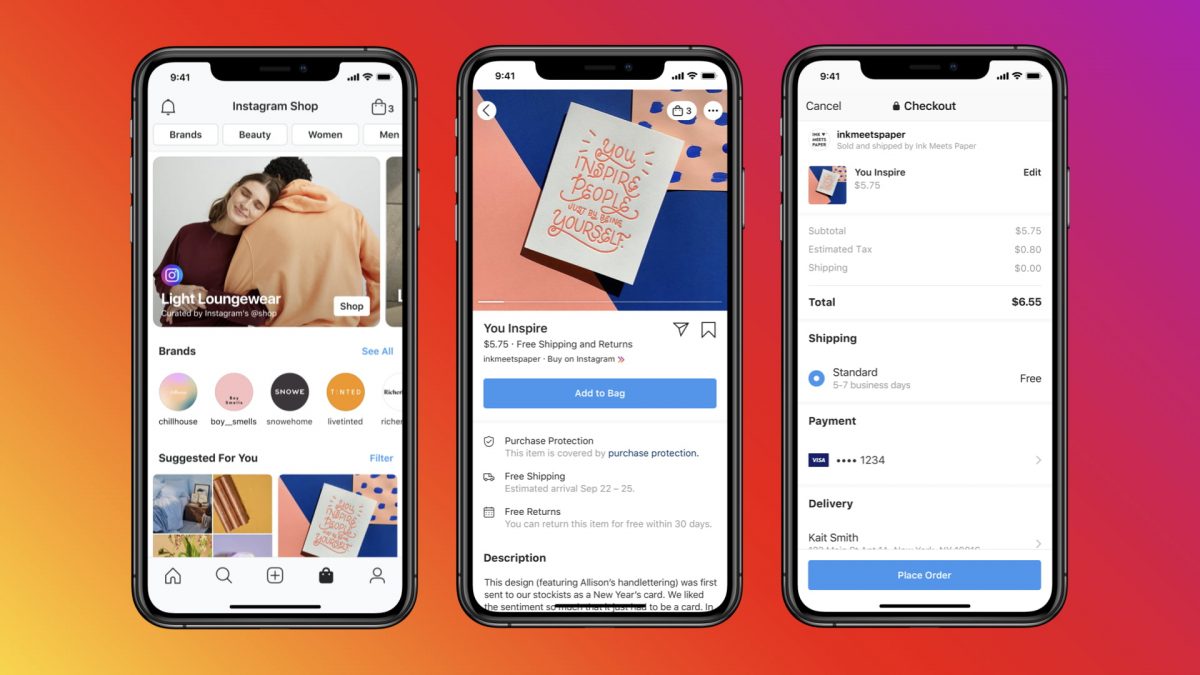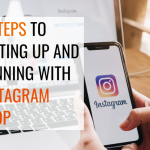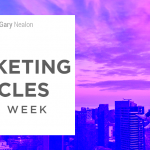Instagram has proven time and time again how effective it is for ecommerce marketing. With more than two billion active monthly users worldwide, and 90% of them following a brand, it’s not surprising that businesses far and wide are flocking to the social media platform to engage with consumers.
However, reaching customers via Instagram isn’t always easy. There are more than 200 million other businesses doing the same thing, and it requires a lot more work than simply creating a business account. The best way to effectively get in front of your audience and increase conversion rates is to have a solid social media marketing strategy in place from the start.
If you’d like to discover how you can use this popular platform to generate engagement and sales, then this guide’s for you. In it, we’ll dive into some tips for selling via Instagram and uncover a few reasons you’ll want to think about using this platform if you aren’t already.
Why Is Instagram Marketing Beneficial to Ecommerce Businesses?
Instagram offers brands more than just a chance to market on the app, but the opportunity to sell, too. The addition of Instagram Shopping in 2019 has since completely changed the game for ecommerce brands using the social media network.
Through the shop feature, customers can make purchases directly from the platform without even having to leave the app. Furthermore, Instagram Shopping offers brands plenty of different methods to advertise ecommerce products, such as shoppable posts and product tags.
(Source)
And Instagram users are loving it. In fact, more than 130 million users tap on shoppable Instagram posts on the app every month, and 70% of shoppers now look to Instagram to make their next purchase.
Here are some other key statistics that prove why marketing and selling on Instagram are so beneficial for ecommerce sellers:
- 50% of Instagram users visit a website after seeing it on a story.
- 62% of users admit becoming more interested in a brand or product after seeing it in Instagram stories.
- Over a third of all Instagram users have used their mobile to purchase a product online.
- Engagement with brands on Instagram is: “10 times higher than on Facebook, 54 times higher than on Pinterest, and 84 times higher than on Twitter.”
- Over 200 million users visit at least one business profile per day.
How Can You Setup and Market on Instagram?
The first step to gaining traction on Instagram is building a business profile. If you haven’t already, you’ll need to create an Instagram Business account, which you can find out how to do here.
Following that, it’s time to set up your Instagram Shop. Here’s a quick guide on how to get started.
Step One: Upload Your Product Catalog
Once your Instagram Business account has been made, the next step is to head to the commerce manager and start uploading your product catalog, photos, and information. To speed up the process, you can add a product catalog directly from Shopify (if you use this ecommerce selling platform). However, you can also upload each product individually.
Step Two: Submit Account for Review
Once you’ve created your catalog, it’s time to submit your account for review. This process usually takes a few days, and you may need to provide more business information.
Step Three: Turn on Instagram Shopping
Now that your Instagram shop has been approved, the final step is to turn on Instagram Shopping and begin marketing to reach your customers.
Marketing on Instagram
When your Instagram account is ready and your shop has been added, it’s now time to get marketing and advertising on the app. The good news is that thanks to its immense user base and various features, there are many ways to reach consumers on Instagram and grow your business.
Here are seven strategies to help increase brand awareness and generate ecommerce sales from Instagram.
Batch, Automate, and Repeat
Social media users value authenticity more than ever before. However, creating unique content from scratch every day is incredibly time-consuming.
According to digital marketing expert Neil Patel, one way to get around this is by using the productivity hack he calls batching. Put simply, batching is the process of completing a task to the best of your ability in one sitting instead of in periodic intervals.
Therefore, instead of waking up each day to create and post Instagram content, a far more productive way to do so is by planning and scheduling all your content in advance.
This method won’t only save you precious time but will also allow you to create effective and consistent content that your Instagram followers demand and desire. For example, maybe in the previous month, you noticed your target audience was interested in a specific product from your lineup: a good idea next month could be to highlight that product in your posts once more.
Once you’ve created your content, let’s say enough for two weeks, the next step is to schedule each post or story. An easy way to do that is to use a social media tool, such as Hootsuite or Buffer, which allows you to easily schedule and publish your content.
Instagram Shopping
Instagram’s shop features allow you to sell and market your products directly on the app. Be sure to make use of these features when posting.
For example, when creating a feed post about a product, be sure to add in a product tag that links to the listed product on your shop. You can also add product tags in Instagram Stories, as well as links to your ecommerce site itself.
Want to get started with Instagram’s shop features? Check out this article.
Responding to Your Audience
It’s not enough to simply post appealing content. Engaging with your audience, such as responding to comments and direct messages, is also a must and is important when forming relationships with your potential customers.
Get our A Guide to Ecommerce Marketing on Instagram - Worksheet delivered right to your inbox.
One of the worst things you can do is sit around waiting for comments to pop up to respond to; the best way to manage your engagement is to build a system with a strict time limit in which you go in and respond to all comments, user-generated content, and messages every day. For example, you could allow a 30-minute window every day at a certain time to respond to audience feedback, comments, and messages.
User-Generated Content
Your Instagram content doesn’t always have to be content that you’ve created. Sharing content that your customers have made is also a fantastic strategy to make your followers feel special and heard while also saving you plenty of time.
Happy customers post about their new products all the time, or even their love for a brand. The next step is to seek out these Instagram posts or stories and ask if you have permission to share them on your business account.
Not only does this strategy demonstrate to your followers that your brand is actively listening and engaging with its customers, but posting such a simple shout-out to a follower also does wonders for customer loyalty and retention. In fact, an Iconosquare study found that 65% of customers said they would be flattered if a brand simply liked their post.
Run Contests and Giveaways
Another strategy to engage consumers, increase brand awareness, and generate sales is to run Instagram contests. Because let’s be honest, who doesn’t love free stuff?
(Source)
The most common contest tactic on Instagram is a giveaway post, where users usually like the post, tag a few friends, and repost it to their story to be in with a chance to win. However, be sure to remember that your giveaways don’t always have to be extravagant to draw in an audience.
People love free things, no matter how big or small. A simple giveaway such as a $200 voucher to shop on your ecommerce store, or one of your products like the brand JBL did, will do just the trick.
Influencers
One of the most popular techniques used by brands, no matter what industry they are in, is influencer marketing. This is because the modern consumer now relies heavily on the likes of influencer recommendations before making a purchase. In fact, 92% of consumers said they would trust an influencer’s review of a brand before making a purchase decision.
However, you can’t just go picking any random influencer to market your products or brand, and sometimes influencers, in general, may not be right for your business. When selecting an influencer to partner with, be sure to check whether their audience is in line with your own or if they have an audience you wish to break into.
Most importantly, focus on engagement. Ensure that your influencer’s audience also engages with them. This is far more important than follower numbers. Engagement is a better indication of whether their audience will convert.
Otherwise, you risk your entire influencer campaign being a waste of time and money as you’ll be trying to sell your products to an audience that’s not interested.
Instagram Ads
Paid ads have been around for quite a while, but for a good reason: because they work. Just like most other social platforms, Instagram offers several options to advertise your content, such as promoted feed posts or stories.
Following an ad campaign, you can then go into your Instagram analytics and review how well it went, which will then allow you to make informed changes to your Instagram Ads for the future.
Instagram Ecommerce Marketing FAQs
Is Instagram the best social media platform for ecommerce businesses to market on?
While every social media platform has its benefits, Instagram, in particular, is equipped with some incredibly advanced ecommerce features that, if used right, can be a goldmine for your online business.
Its shop features, coupled with the fact that it’s one of the best social media networks for influencer marketing, make it an incredibly beneficial platform for many ecommerce businesses to use.
What are the best ways to market on Instagram?
As we’ve seen, there are many different strategies and techniques for marketing on Instagram, such as sharing user-generated content, running giveaways, and of course, influencer marketing.
Not sure which strategies to use? Try to think about what your audience is most likely to respond best. Then get to work executing that plan. If you don’t get the results that you’re after, try another strategy or adjust your approach slightly and try again.
How can I sell my products on Instagram?
To sell on Instagram, you’re going to need a business page, and then you’ll want to set up Instagram Shopping. The next step is creating content about your products and using the various shopping features to promote them.
Can I sell on Instagram with Shopify?
Yes, with Instagram Shopping, brands can sell products directly from the platform by connecting their store to the Shopify platform when setting up the tool.
The Next Step: Creating Your Instagram Marketing Strategy
The beauty of Instagram is that it offers countless methods for ecommerce businesses to engage with and sell to their audience. However, the best way to achieve this is to have a solid marketing strategy in place.
Here’s how you can get started:
Step One: Before you can begin marketing, you must set up your brand’s business Instagram account and Instagram Shopping. To find out more about how to do this, check out this article.
Step Two: Once you’re all set up, think about your target audience and what type of content or marketing efforts they would best respond to. For example, are your customers engaging with influencers? What other brands in your market do they follow, and how do they engage with them?
Step Three: Using the information gathered in step two, it’s now time to gear up your strategy and start marketing on Instagram. The best approach when first starting out is often trial and error. Sometimes your content ideas won’t work out at first, and that’s okay. Look at your Instagram analytics and use that information to guide future content and plan different ways of promoting it.
Bonus Tip: Producing new content and posting every day takes time. One way to help automate some of your social media content is with social media tools. Some great tools are BuzzSumo, Buffer, and Hootsuite.
Looking to develop a marketing strategy for your ecommerce business? Reach out today for your free 20-minute consultation so we can create your winning strategy and start generating more sales.
Get our A Guide to Ecommerce Marketing on Instagram - Worksheet delivered right to your inbox.






